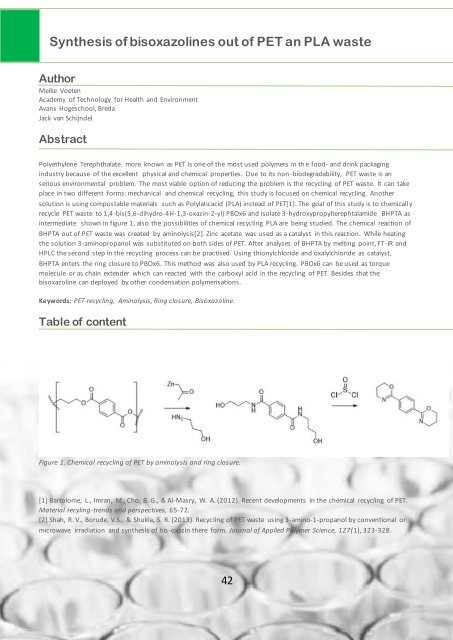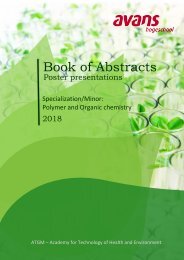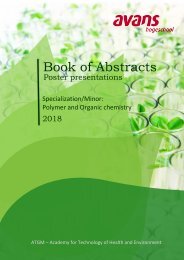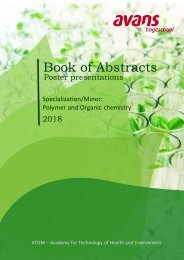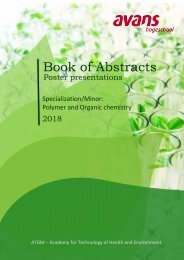Book of abstracts version 5
Create successful ePaper yourself
Turn your PDF publications into a flip-book with our unique Google optimized e-Paper software.
Synthesis <strong>of</strong> bisoxazolines out <strong>of</strong> PET an PLA waste<br />
Author<br />
Meike Voeten<br />
Academy <strong>of</strong> Technology for Health and Environment<br />
Avans Hogeschool, Breda<br />
Jack van Schijndel<br />
Abstract<br />
Polyethylene Terephthalate more known as PET is one <strong>of</strong> the most used polymers in th e food- and drink packaging<br />
industry because <strong>of</strong> the excellent physical and chemical properties. Due to its non -biodegradability, PET waste is an<br />
serious environmental problem. The most viable option <strong>of</strong> reducing the problem is the recycling <strong>of</strong> PET waste. It can take<br />
place in two different forms: mechanical and chemical recycling, this study is focused on chemical recycling. Another<br />
solution is using compostable materials such as Polylaticacid (PLA) instead <strong>of</strong> PET[1]. The goal <strong>of</strong> this study is to chemicall y<br />
recycle PET waste to 1,4-bis(5,6-dihydro-4H-1,3-oxazin-2-yl) PBOx6 and isolate 3-hydroxypropylterephtalamide BHPTA as<br />
intermediate shown in figure 1, also the possibilities <strong>of</strong> chemical recycling PLA are being studied. The chemical reaction <strong>of</strong><br />
BHPTA out <strong>of</strong> PET waste was created by aminolysis[2]. Zinc acetate was used as a catalyst in this reaction. While heating<br />
the solution 3-aminopropanol was substituted on both sides <strong>of</strong> PET. After analyses <strong>of</strong> BHPTA by melting point, FT-IR and<br />
HPLC the second step in the recycling process can be practised. Using thionylchloride and oxalylchloride as catalyst,<br />
BHPTA enters the ring closure to PBOx6. This method was also used by PLA recycling. PBOx6 can be used as torque<br />
molecule or as chain extender which can reacted with the carboxyl acid in the recycling <strong>of</strong> PET. Besides that the<br />
bisoxazoline can deployed by other condensation polymerisations.<br />
Keywords: PET-recycling, Aminolysis, Ring closure, Bisoxazoline.<br />
Table <strong>of</strong> content<br />
Figure 1. Chemical recycling <strong>of</strong> PET by aminolysis and ring closure.<br />
[1] Bartolome, L., Imran, M., Cho, B. G., & Al-Masry, W. A. (2012). Recent developments in the chemical recycling <strong>of</strong> PET.<br />
Material recyling-trends and perspectives, 65-72.<br />
[2] Shah, R. V., Borude, V.S., & Shukla, S. R. (2013). Recycling <strong>of</strong> PET waste using 3-amino-1-propanol by conventional or<br />
microwave irradiation and synthesis <strong>of</strong> bis-oxazin there form. Journal <strong>of</strong> Applied Polymer Science, 127(1), 323-328.<br />
42


